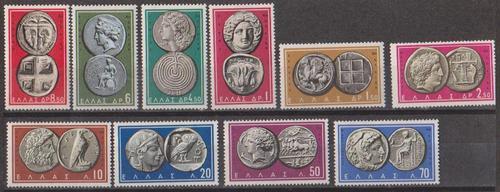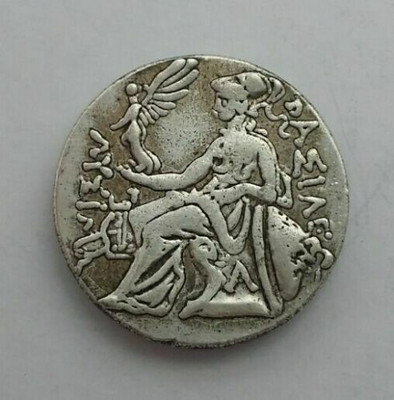
Her portrayal in that Figure is in assured archaic style, and manifests a disturbingly arresting and mysterious face. The helmet and olive leaves in Figure A stress her latter role. She was the patroness of crafts and warlike protectress of cities. Unerringly the obverses of Athenian tetradrachms bear the head of the goddess, the only Greek deity to give its name to a city or state. In contrast, the owl on the reverse is surprisingly crude compared with Figure B and whatever impact the design might have had is choked by the clutter of lettering in the field. Here the portrayal of Athena is executed with careful attention to detail but drained of character. Extensive lettering in the field and, to the right of the bird, the forepart of a lion r. Owl turned partly r., with facing head, perched on an amphora (the usual letter erased by wear). Head of Athena, wearing a drop earring and triple crested helmet embellished with an image of Pegasus and foliage, and the forepart of four horses r. Figures C and D show one of the 'New Style' tetradrachms struck in 164/3 BC. The greatly inferior evolution of the Athena/owl designs in the following centuries would have been unthinkable in the fifth century BC.

Modern parlance - a consistent message, as befitted an issue of international importance. The impact was sustained by continuing the design over decades with only the subtlest of change, maintaining - in That is the vigorous image conveyed at this period by the design and execution of the coins themselves. There is, however, a third ingredient which has helped the coinage to achieve a unique status. Thus, Athenian coinage symbolised political dominance and was, itself, a tangible expression of economic power. Military and naval might was underpinned by the copious silver mined at Laurium, as well as payments from tributary powers and from the treasury of the Delian League. In the intervening period Athens consolidated a successful democracy, expanded its political and economic power across the Greek world and created an environment in which artistic and intellectual activity could thrive as never before or since. The defeat of the Persian orces of Darius, at Marathon in 490 BC, heralded a golden age for Athens which lasted until the disastrous Peloponesian War led to its subjection to Sparta in 404 BC. Its reverse - to choose but one example - graces the cover and spine of Hammond's history of ancient Greece. The Athenian tetradrachm is possibly the best known and most illustrated of all ancient Greek coins.

Olive sprig and crescent to left and AΘE to right. Hair in two even loops across brow and temple. Head of Athena r., wearing helmet decorated with three olive leaves and a curling palmette.


 0 kommentar(er)
0 kommentar(er)
